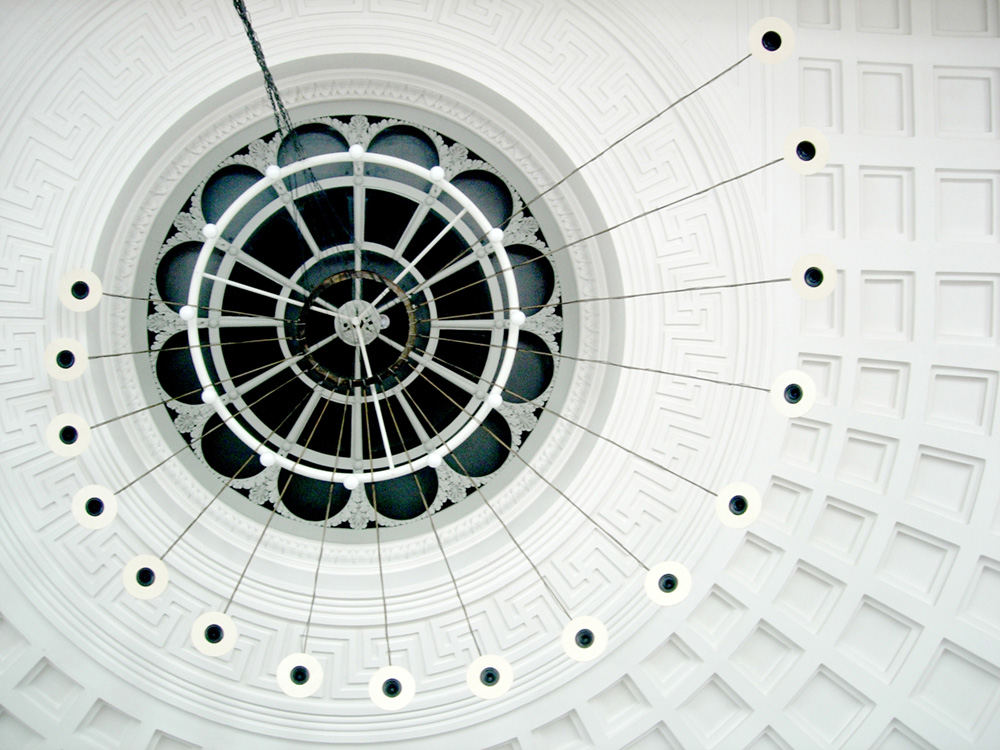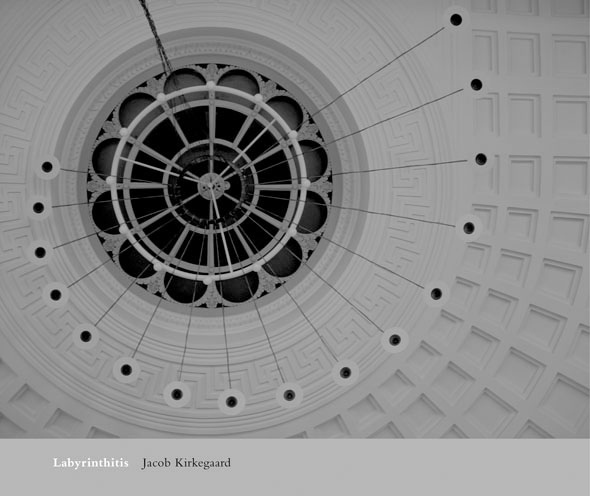

L A B Y R I N T H I T I S
4- or 16-channel composition / sound installation (2007) 40-minutes. Commissioned by- and first performed at the Medical Museion, Copenhagen, Denmark. Limited release of the composition on Touch (2008)
Labyrinthitis works with otoacoustic emissions generated by the artist’s ears to produce otoacoustic emissions in the ears of the listeners
The 16 speakers were installed on metal rods of varying lengths to create a 3-dimensional ascending spiral hanging from the dome ceiling
of a former operating theatre in the museum.
by Douglas Kahn
To my knowledge Jacob Kirkegaard has, in Labyrinthitis, composed the first piece of art which directly incorporates active hearing. Kirkegaard is sitting in a soundproof booth, a specialized scientific room, with tiny speakers and microphones in his ears. The speakers are sending tones into his inner ears that create tones generated by the ear itself in response. Two tones are sent in and one, a third tone, comes back in response. These ear sounds are, in turn, picked up by the microphones and amplified. Kirkegaard then uses them in performance to evoke ‘third tones’ in the ears of the audience which, in effect, creates a situation where the audience hears him hearing and hear themselves hearing. In this way alone, Kirkegaard has countered Duchamp’s dictum, “One can look at seeing, one can’t hear hearing.”
Hearing is usually thought to be a passive sense, traveling one direction from the outside in. Passive hearing in one direction involves transduction, from the energy state of mechanical vibrations of sounds in the air or body, to electrical and chemical states trafficked in the nervous system and brain. Sounds usually come from outside, vibrate the eardrum which vibrates the tiny bones of the middle ear, in turn vibrating the fluid in the cochlea, a tiny organ on either side of the head shaped like a seashell. Listen and you can hear the ocean, tiny hairs swaying like seaweed in the shallows of the surf. It is counter-intuitive to imagine the sound of active hearing produced in this underwater scene: the seaweed would cause the waves. It would be as though Jean Piaget’s kids were right when they said that the movement of trees caused the wind.
Knowledge of active hearing has developed since the late 1970s, due to an increased understanding of the mechanisms in the outer hair cells of the cochlea. These specialized hair cells change shape in response to electrical stimulation from the nervous system, and when they do it in concert they create vibrations in the fluid chambers of the labyrinth. To sound coming from the outside, they respond with a tiny amount of sound of their own. These sounds are called otoacoustic emissions (OAE) and are thought to play a part in ‘cochlear amplification’, a selective reinforcement of certain frequency characteristics.
When the cochlea spontaneously emits sounds in the absence of external sound, it is called spontaneous otoacoustic emissions (SOAE). But before massaging your auricles in a first awkward attempt at enunciation, you should know that SOAEs are inaudible to the listener; that is, to the person with the ears, let alone audible to anyone else, without specialized equipment. When OAEs are evoked by external tones, they are called distortion products (DPOAE) and can be heard. Labyrinthitis consists of DPOAEs. They are what Kirkegaard and those listening to him hear.
Jacob Kirkegaard sitting in a sound proof both listening to the sounds of his body leads, of course, to the image of John Cage sitting in an anechoic chamber hearing the sounds of his body. As the story goes, Cage heard a low sound and a high sound. The engineer told him it was the sound of his blood in circulation and the sound of his nervous system in operation. It is unclear which of Harvard’s three anechoic chambers Cage entered and thus what type of engineer was in attendance. Thus the legend could be based upon an educated guess by an electrical engineer. Others have thought that the high register Cage heard was a touch of tinnitus, in which case it would not have required an anechoic chamber to legitimize his central aesthetic principles. The composer James Tenney, a longtime student of psychoacoustics, told me he thought that Cage might have heard SOAEs. But this could not be the case if they are inaudible.
It is impossible to go back and seat Cage into a scientific space with fewer variables. Yet it is clear that he found the irrepressible sounds of his own body very significant. Their very existence legitimized his counter-intuitive notion of silence as the absence of the absence of sound. In fact, he listened to these scientifically legitimized sounds as he would listen to no other sound, by letting his mind intercede: he asks himself, “what is that low sound; what is that high sound?” Otherwise, he strove to hear “a sound in itself.” There is no such thing as a sound in itself, or sounds in themselves in active hearing. What one hears is, at its physiological basis, the nervous system reaching out to sound with its own sound. Active hearing, in other words, clears a discursive pathway to better appreciate all the conditioning of hearing from the inside out, including acts of directing one’s attention.
Kirkegaard and Cage have not been the only people listening to their bodies talk in clinical circumstances. William Burroughs conducted crude “Throat Microphone Experiments” hoping to hear subvocal speech, and more successfully imagined a sound test of the body in his cut-up novel, “The Ticket that Exploded”. A Cockney attendant leads Nova Mobster Bradly into a specialized room “with metal walls that smelled of ozone and flash bulbs…” and then, after mapping a line down the center of his body, into a booth where “small microphones were attached to the two sides of his body and the sounds recorded on two tape recorders – He heard the beating of his heart, the gurgle of shifting secretions and food, the rattle of breath and scratches of throat gristle – crystal bubbles in the sinus chambers magnified from the recorders – The attendant ran the tape from one recorder onto the other to produce the sound of feedback between the two body halves – a rhythmic twang – soft hammer of heartbeats pounding along the divide line of his body…”
Even the stethoscope was trained back onto the body of its maker. In the early 19th Century, René-Théophile-Hyacinthe Laënnec, the grandfather of the instrument for listening to bodies, became frustrated during his own illness when he needed it the most. The stiffness of the stethoscope prevented him from contorting to hear himself and he distrusted the reports of others. Once he calmed down, he realized that he could hear his insides himself, his heartbeats and the sonic signatures of a whole set of digestive issues. Doctor Benway: heal thyself.
The ear sounds we hear in Labyrinthitis are high pitched, on the upper register of the piano keyboard, which the great 19th Century physiologist and physicist Hermann von Helmholtz imagined snaking submerged up the coil of the cochlea. They rise above guttural timbre of the throat and the brooding noises of the gut, and thus lack the timbre that once could have associated them with modernist notions of musical noise. OAEs, in fact, are more akin to the anti-noise of sine waves, the aperiodic waveforms of modernist noise versus the periodic waveforms of musical tone. They are musical tones pitched at a sustained pitch, a quintessential violin, the first chair of the music that the avant-garde sought to drown out the noise of percussion and the outside world.
Hearing has been imagined in the past as a percussive affair: the sounds of the outside world beating on eardrums. Only when the vibrations make their way through the tiny bones of the middle ear to the tiny hairs in the cochlea are they transformed from mechanical motion into the electrical and chemical impulses sensible to the brain. This change of one energy state to another is called transduction. We can caricature passive models of hearing as one-way routes of transduction: sounds are sucked into the skull and muscle memory by attention, affect, language, routine and other human preoccupations. Any reverse transduction does not go back through the ear, but finds its way back out instead through the mouth, gestures, or actions.
The provocation of Kirkegaard’s Labyrinthitis is to show that two-way traffic happens in the ear, at the point that transduction begins. This is what the astrophysicist Thomas Gold first proposed in his 1948 biophysics paper describing OAEs as “a feedback system consisting of a mechanical-to-electrical transduction process coupled to an electrical-to-mechanical transduction process.” The physiological fact of transductive reversal in active hearing reroutes relationships among technology, nature and the body. The tiny microphones and speakers in Kirkegaard’s ears, with sounds and electronic signals going both directions, are not separated by a gulf of nature and technology, but are instead in discursive and actual circuit with motions, energies, forces, impulses and radiations. This has been a concern of Kirkegaard in many of his other works. In Labyrinthitis, sounds interact both inside and outside the confines of individual experience, as listening is introduced into the tranductive flows of the world.
Douglas Kahn, San Francisco 2008
LABYRINTHITIS
Jacob Kirkegaard & Touch Music ©
2008
CD - 38 minutes. TOUCH 2008
Originally commissioned by the Medical Museion in 2007, Copenhagen Denmark and in 2008 released as a special designed limited edition on TOUCH, this CD comes with two essays especially written for the release by Douglas Kahn and Anthony Moore. Labyrinthitis received a prize from the Danish Arts Council and was by The Wire magazine selected as one of the 10 best CDs of 2008 in their Outer Limits catagory. Scroll down to read about the piece.
Limited edition of 1000. This is Jacob Kirkegaard's 3rd solo CD for TOUCH. Labyrinthitis is sold out but available as 320kbps digital downloads through Touch.

Jacob Kirkegaard © 2007-2008
All rights reserved